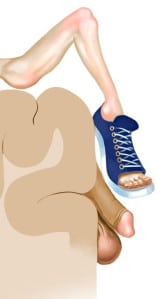The foot territory is next to the genital territory in the brain
In the somatosensory homonculus (S1) the territory representing the feet is next to the brain areas representing the genitals. This links to the widely reported S1 theory explaining the feet as erogenous zones (Ramachandram and Blakeslee 1988).

This is a neuroscience (neuroanatomy) nugget which links to anecdotal pain stories that some foot injuries may be erogenous, that the sense of urination can be felt in phantom lower limbs and stumps can be erogenous. The explanations given usually link to plasticity ie a smudging or fuzziness of boundaries between the two territories in the brain.
Not a bad story! I have never heard anybody with a painful foot problem report it was erogenous though some have reported a weird pelvic area pain. I guess I have never really asked! I recall a gentleman with a phantom leg pain who reported to me that a full bladder, thus early morning, really made his phantom limb hurt. He was thrilled and relieved to see the homunculus!
It is a nugget because it is fascinating to most people, everyone has heard of erogenous toes, it helps initial awkward discussions of genital pain and it helps discussions of plasticity. And it’s hard to forget.
An aside – be wary with your stories – there is little science here: In all the zapping and brain prodding done in establishing homunculi, erogenous sensations were not reported (maybe the recipients just shut up?). Readers could well peek at a useful paper by Turnbull et al 2014 reporting from a large study that feet are really not that erogenous at all, it is items associated with the feet which are part of common fetishes. This paper also reminds us of the simplicity of the nugget as described above. If your foot or foot areas feels erogenous, then this is likely to have its own neurosignature likely involving insula, thalamus, periaqueductal grey, S1, vision, memory etc. ie not as simple as two bits of brain swapping function.
Shouldn’t stop you using the nugget though!
– David Butler
www.noigroup.com
Ramachandran VS & Blakeslee S (1988) Phantoms in the Brain. London, Fourth Estate Ltd
Turnbull OH et al (2014) Reports of intimate touch: Erogenous zones and somatosensory cortical reorganisation. Cortex 53: 147-154
“Neuroscience nuggets”
Neuroscience nuggets are information nuggets – pieces of biological information based on statement or metaphor that can be used as educational analgesia, explicit education or part of overall story telling. We have collected over 100 of these for a book and will release one or two a week with a short description and references if appropriate.
Explain Pain 2nd Ed, the Graded Motor Imagery Handbook and all noigroup courses are all bursting at the seams with the latest and greatest neuroscience nuggets; click on the links to get your hands on a copy or to find a course near you

That explains everything………I think I’ll stop sucking my big toe in yoga now…….